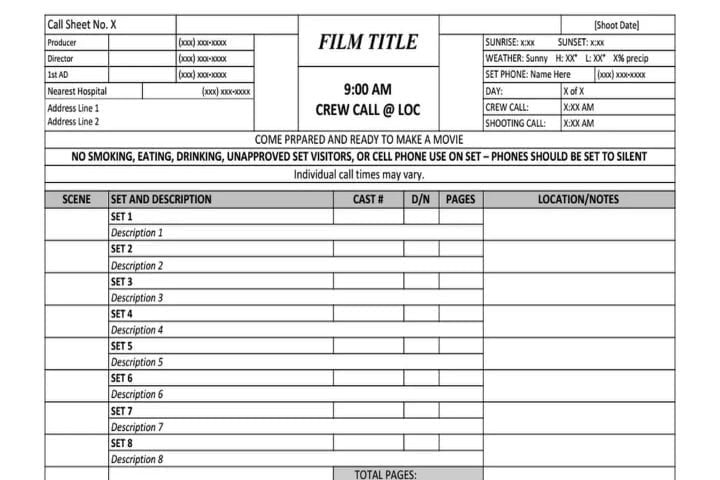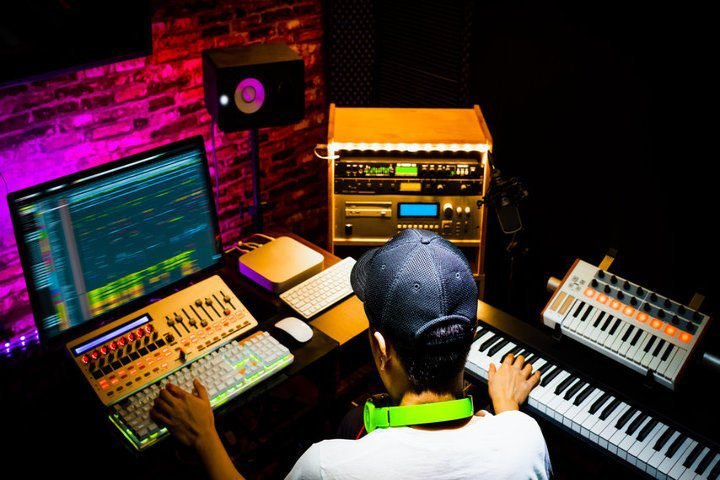CUET UG Film Production
Shooting Stage in Film Production
After the pre-shooting stage arrangements are completed, the shooting process starts. The shooting timeline differs according to the shooting locations and type of film. Some have a continuous schedule, but many have different schedules in different shoot locations.
Ideally, all producers would prefer to finish the shooting on one schedule, but it is often not possible for various reasons. Sometimes, the lead actors may not be available continuously. Sometimes, the screenplay may demand parts of the film be shot in different seasons; sometimes, there could be other restrictions on the availability of locations, etc.; therefore, two or three major schedules are usually prepared.
Shot, Scene, and Sequence
Understanding the difference between a shot, scene, and sequence is fundamental in film production.
- Shot: A shot is a continuous sequence of frames captured by the camera without interruption. It represents a single, uninterrupted view. Shots can vary in duration, angle, and composition.
- Scene: A scene is a series of shots forming a complete narrative unit in a film. Scenes usually occur in a single location and involve a specific set of characters and actions that advance the storyline.
- Sequence: A sequence is a collection of related scenes grouped to form a larger narrative segment. Sequences often serve to develop a specific storyline or thematic element within the film. They may involve multiple locations, characters, and subplots.
Shooting Schedule
The production team manages logistics and transportation during shooting. For every shooting schedule, all artistic or logistical requirements are planned daily. By the first day of filming, every crew member is expected to be familiar with the shooting schedule, and all the equipment for the day’s work should be available. Each crew member is given a call sheet indicating their role on set.

The director and the director of photography finalize the positioning of the lights. Cameras and microphones are positioned, and camera movements and lighting adjustments are rehearsed. Marks are placed on the floor to guide the actors’ movements when the scene is shot.
The actors participate in rehearsing, costume, hair, and makeup. Once the technical aspects of shooting the scene have been firmly established and the actors are dressed, they are called to the set.
When the director is ready to shoot, an assistant calls for silence. If shooting occurs in a studio, the doors are closed, and a red light is switched on to signal that entry to the set is forbidden.

The director instructs the camera operator and sound recordist to begin recording. The scene and take numbers are read out, and the hinged clapperboard is snapped shut. The director then calls for “action,” and the actors begin their performance.
The first take is rarely the successful one. Repeated takes are, therefore, a part and parcel of shooting activity. A scene may be shot with more than one camera at once. This allows for more creative options while editing.

Shooting Ratio
However, it increases the shooting ratio, which suggests how much film is shot compared to the running time of the finished film. For instance, a 5-minute film with 30 minutes of footage would have a shooting ratio 6:1.

In the Golden Age of Hollywood (1930–1959), it was normal to have a 10:1 ratio. A 90-minute feature film would have shot roughly 25 hours of film. Alfred Hitchcock was known to have a 3:1 ratio to control the edit. However, in recent years, the shooting ratio has skyrocketed due to the relatively inexpensive nature of digital filmmaking.
Maintaining Daily Shooting Target
While the director focuses on filming the main scenes with the lead actors, shooting other footage may be assigned to other units. A second unit is often used for filming, shooting fights, and action sequences in other locations.
The director and production team screen the footage at the end of each day’s shooting. This material is known as the “dailies,” or “rushes,” and is used to evaluate the film’s progress. It also points out mistakes during the day’s filming and scenes that need to be re-shot while the actors are still available and the sets are still up.

Production and direction may not be able to control all the factors that affect the shooting process. Therefore, significant collaboration between the director, assistant director, and DOP is required at the shooting stage.
The main focus is staying on schedule and meeting the daily shooting target. At the end of every filming day, the lead production team members check in with one another to determine if daily production goals are met and if plans need to be adjusted for upcoming shooting days.
Film Shooting Format: From Analog to Digital to Mobile
Digital technology has revolutionized the film industry. It allows for more efficient and cost-effective production, editing, and distribution of films.
Bejoy Nambiar used the “Red One” digital camera for the first time in India to shoot his film, Shaitan (2011). Tigmanshu Dhulia was the first to use an “Arri Alexa” digital camera to shoot Saheb Biwi Aur Gangster (2011).
Slumdog Millionaire (2009) was almost entirely shot in digital and won the Oscar for Best Cinematography, putting the ultimate stamp of approval on digital cinematography. In 2013, The Wolf of Wall Street became the first major studio production to distribute entirely in digital form.
In Bollywood, Rajkumar Hirani’s PK (2014) was one of the last few films shot on celluloid as film production transitioned to the digital format from 2013–2014 onward.
Cost, Convenience, and Capability
In cinema, cost, convenience, and capability are key drivers. Digital shooting formats have allowed a greater number of films to hit multiplexes and festivals. Let’s discuss each factor one by one:
The Cost Factor

A 400-foot roll of 35mm Kodak film can accommodate up to 4 minutes of footage and costs up to Rs. 16,000. For a 2-hour film with retakes, the cost of the film roll itself would go up to Rs. 50 lakhs. Additionally, distributing the film would cost another Rs 5 lakh. Therefore, the total cost of creating footage and distributing it would be around Rs. 55 lakh. This price tag is one of the main reasons that filmmakers were keen on shifting over to digital.
Therefore, the benefits of digital cinematography are self-evident, such as the savings in film stock costs. Films can be edited on-location and captured on hard drives that can be erased and reused.
The Convenience Factor
Another benefit of digital technology is that it has made the job of cinematographers much easier and more cost-effective. The use of a smaller and lighter camera has opened up endless creative possibilities.
With the help of a steadycam or body-mounted camera rig, action shots such as running down a hill or jumping off a bridge can be captured more conveniently and with greater ease than before.
Shooting in tight spaces is made easy with lightweight cameras like the Blackmagic Cinema Camera, DSLRs, and point-and-shoot cameras like the GoPro and DJI Pocket.
Shooting on stock requires many rehearsals, but digital cameras offer a more cost-effective and efficient option. Filmmakers can now shoot faster and more frequently.
The Capability Factor
When it comes to cine cameras, their capabilities can be broken down into dynamic range, resolution, and special effects such as slow motion and vari-speed. Independent filmmakers can now create small-budget films using digital tools.
Digital has also allowed films to advance technologically, opening up new avenues such as visual effects, 3D, and 4D projection. It has allowed the movie-watching experience to be more immersive.
Analog vs Digital Debate

For many years, movies were shot, processed, and projected in theaters using celluloid film. This was the norm in the filmmaking industry until a digital revolution took place around 2010. Since then, 85% of Indian films have gone digital, which is a major departure from the country’s 135-year-old cinematic heritage based entirely on analog prints.
Prasad Film Laboratories, which was once the largest chain of post-production facilities in India, shut down its celluloid-processing units and rebranded itself as a pioneer in digital services in 2012.
Major players in the film industry, such as Eastman Kodak and Fuji, also faced challenges during this time. Eastman Kodak filed for bankruptcy protection, while Fuji stopped selling negatives and 35mm film stock.
Companies like ARRI and Panavision stopped producing film cameras and started focusing on the design and manufacture of digital cameras. Film labs were closed down, and film stock manufacturers went bankrupt.
However, there is a growing community of filmmakers who believe that while digital cameras are advancing and becoming more capable of emulating the qualities of film, nothing can still beat the precision and visual quality that film provides. Films are also more effective at capturing natural highlights and rays in bright conditions.

Shooting on analog captures location tones and textures better than digital. Flawless skin textures can be captured without correction. In film, each frame of a picture is recorded on the negative, creating a unique grain structure for every 24 frames per second, which gives it a lively feel.
Furthermore, the shelf life of a movie shot on digital cameras is only 15 years because of newer technologies cropping up, while those shot on film, if preserved, can last more than 100 years.
Conclusion
The future holds an exciting time for film enthusiasts, as both 70mm and 35mm formats are making a comeback to the big screen, after years of being overlooked. Hollywood is leading the charge with highly anticipated films like ‘Oppenheimer’ and ‘Killers of the Flower Moon’ shot on film reels. In India, Kollywood director Lokesh Kanagaraj is set to shoot his next project, ‘Thalaivar 171,’ starring Rajinikanth, on IMAX reels.
Exciting times lie ahead for filmmakers and enthusiasts alike, and everyone is expecting to see the co-existence of both technologies in the near future.
The CUET UG Mass Communication syllabus contains this topic under the Film Production section.





